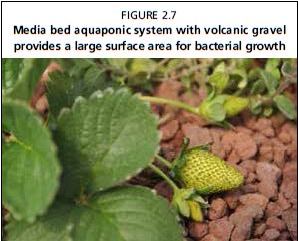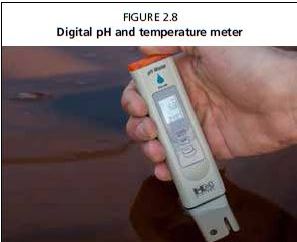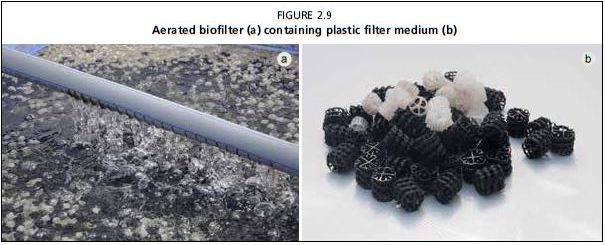2.3 MAINTAINING A HEALTHY BACTERIAL COLONY
The major parameters affecting bacteria growth that should be considered when maintaining a healthy biofilter are adequate surface area and appropriate water conditions..
2.3.1 Surface area
Bacterial colonies will thrive on any material, such as plant roots, along fish tank walls and inside each grow pipe. The total available area available for these bacteria will determine how much ammonia they are able to metabolize. Depending on the fish biomass and system design, the plant roots and tank walls can provide adequate area.. Systems with high fish stocking density require a separate biofiltration component
FIGURE 2.7
Media bed aquaponic system with volcanic gravel provides a large surface area for bacterial growth

where a material with a high surface area is contained, such as inert grow media - gravel, tuff or expanded clay (Figure 2.7).
2.3.2 Water pH
The pH is how acidic or basic the water is. The pH level of the water has an impact on the biological activity of the nitrifying bacteria and their ability to convert ammonia and nitrite (Figure 2.8). The ranges for the two nitrifying groups below have been identified as ideal, yet the literature on bacteria growth also suggests a much larger tolerance range (6-8.5) because of the ability of bacteria to adapt to their surroundings.
Nitrifying bacteria Optimal pH
Nitrosomonas spp. 7.2-78
Nitrobacter spp. 7.2-8.2
FIGURE 2.8 Digital pH and temperature meter

However, for aquaponics, a more appropriate pH range is 6-7 because this range is better for the plants and fish (Chapter 3 discusses the compromise on water quality parameters). Moreover, a loss of bacterial efficiency can be offset by having more bacteria, thus biofilters should be sized accordingly.
2.3.3 Water temperature
Water temperature is an important parameter for bacteria, and for aquaponics in general. The ideal temperature range for bacteria growth and productivity is 17-34 °C. If the water temperature drops below 17 °C, bacteria productivity will decrease. Below 10 °C, productivity can be reduced by 50 percent or more. Low temperatures have major impacts on unit management during winter (see Chapter 8).
2.3.4 Dissolved oxygen
Nitrifying bacteria need an adequate level of dissolved oxygen (DO) in the water at all times in order to maintain high levels of productivity. Nitrification is an oxidative reaction, where oxygen is used as a reagent; without oxygen, the reaction stops. Optimum levels of DO are 4-8 mg/litre. Nitrification will decrease if DO concentrations drop below 2.0 mg/ litre. Moreover, without sufficient DO concentrations, another type of bacteria can grow, one that will convert the valuable nitrates back into unusable molecular nitrogen in an anaerobic process known as denitrification.
2.3.5 Ultraviolet light
Nitrifying bacteria are photosensitive organisms, meaning that ultraviolet (UV) light. from the sun is a threat. This is particularly the case during the initial formation of the bacteria colonies when a new aquaponic system is set up. Once the bacteria. have colonized a surface (3-5 days), UV light poses no major problem. A simple way to remove this threat is to cover the fish tank and filtration components with UV protective material while making sure no water in the hydroponic component is exposed to the sun, at least until the bacteria colonies are fully formed..
Nitrifying bacteria will grow on material with a high surface area (Figure 2.9), sheltered using UV protective material, and under appropriate water conditions (Table 2.1).
FIGURE 2.9
Aerated biofilter (a) containing plastic filter medium (b)

TABLE 2.1
Water quality tolerance ranges for nitrifying bacteria
